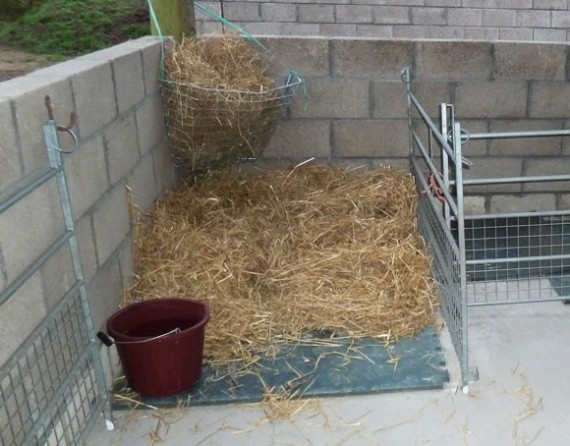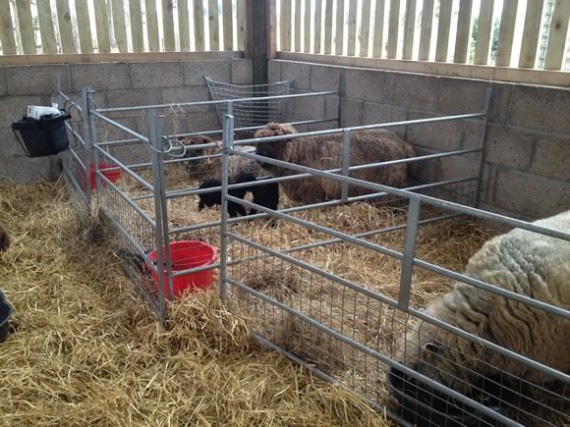Preparing for lambing
About two weeks before the first lambs are due, it’s time to start preparing for lambing.
Mothering pens
Whether you are lambing inside or outside, it’s a sound idea to build some “mothering pens” in which each newly lambed ewe can be penned with her lambs for 12 – 48 hours.
Doing this allows you to check easily that the ewe has milk, that the lambs are suckling, that ewe and lambs are healthy and that they have bonded. It also makes post lambing tasks, like worming, fluking and foot trimming the ewe and tailing lambs easier.
The length of time that each ewe and lamb(s) needs to be penned depends on a number of factors – the weather, the age, breed and experience of the ewe, the number of lambs and how much space you have, relative to the number of ewes lambing.
- Lambs can survive in pretty appalling weather if there is sufficient shelter and they have full bellies but if it’s wet and windy, lambs can lose body heat quickly so if the weather is bad, you might want keep lambs in a bit longer, if you have space. If you have to turn them out, consider using plastic lamb coats.
We usually put the livestock trailer in the field with the ewes and lambs, open and bedded with straw. We find that the lambs play in it and sleep in it if the weather is bad; the ewes tend to lie at the bottom of the ramp. This also has the advantage that when you come to load your sheep, they are generally quite happy to get in.
- An experienced ewe might only be in for 12 hours, if the weather is OK and ewe and lambs are fit.
- A first time lamber with twins might be in for 48 hours, until I am sure that the ewe knows that she has two lambs and that both lambs are well mothered. I have found that, sometimes, inexperienced ewes forget about the second lamb and wander off with the bigger, dominant lamb.
 Prepared lambing pen.
Prepared lambing pen.
Our mothering pens are about 6ft x 3ft, which means that the ewe is less likely to lay or stand on the lambs and there is plenty room for me, if I need to help lambs to suckle and for when I give the ewe her post-natal make-over and tail the lambs prior to turnout. It also happens to be the sizes of our hurdles.
 Occupied lambing pens.
Occupied lambing pens.
Water and feed for ewes
Each pen needs a water bucket; newly lambed ewes drink a lot. I’ve thought about fixing the bucket to prevent it being knocked over but I’ve decided that if a lamb inadvertently falls into the bucket, it’s more likely to get out if the bucket isn’t fixed and I’d rather have a wet pen than a drowned lamb.
Each pen also needs a feed bucket or trug and a hayrack. You can buy small hayracks that fit over a hurdle and are accessible from two pens, relatively inexpensively or, if you are handy, it wouldn’t be difficult to make some, using weld mesh. If you put hay on the floor, most of it will be wasted.
Bedding
Ideally, pens should to be completely cleaned and bedded with fresh straw after each ewe is turned out to prevent the build up of disease but time constraints may prevent this. A reasonable alternative is to remove any heavily soiled straw, use a dry disinfectant powder and add fresh straw.
- Previous « Metabolic diseases at lambing
- Next Lambing box »

About Rosemary Champion
Rosemary lives on a 12 acre smallholding in Angus, in the east of Scotland, where she keeps Ryeland Sheep, Shetland cattle and assorted poultry. She was destined to be a smallholder from an early age.
Further Reading
 Sheep Medicine Phillip R. Scott |  Sheep Health, Husbandry and Disease: A Photographic Guide Agnes C. Winter |  The Veterinary Book for Sheep Farmers David Henderson |  The Sheep Keeper's Veterinary Handbook Agnes Winter & Judith Charnley |  Beautiful Sheep: Portraits of Champion Breeds Kathryn Dun |
Smallholding shop
When you click links below and make a purchase, this may result in this site earning a commission from eBay.

Countryman Shearer Comb each
Countryman Shearer Comb. Ideal… from £13.04 + p&p

Obstetric lube Gel 2li
Obstetric Gel. 2ltr. Non… from £4.30 + p&p

R15 Clipper Oil 250ml
R15 Clipper Oil. To minimise… from £4.29 + p&p

Sure Sired Ram Crayon Harness – Nylon
Pin Type Crayon… from £12.99 + p&p
















